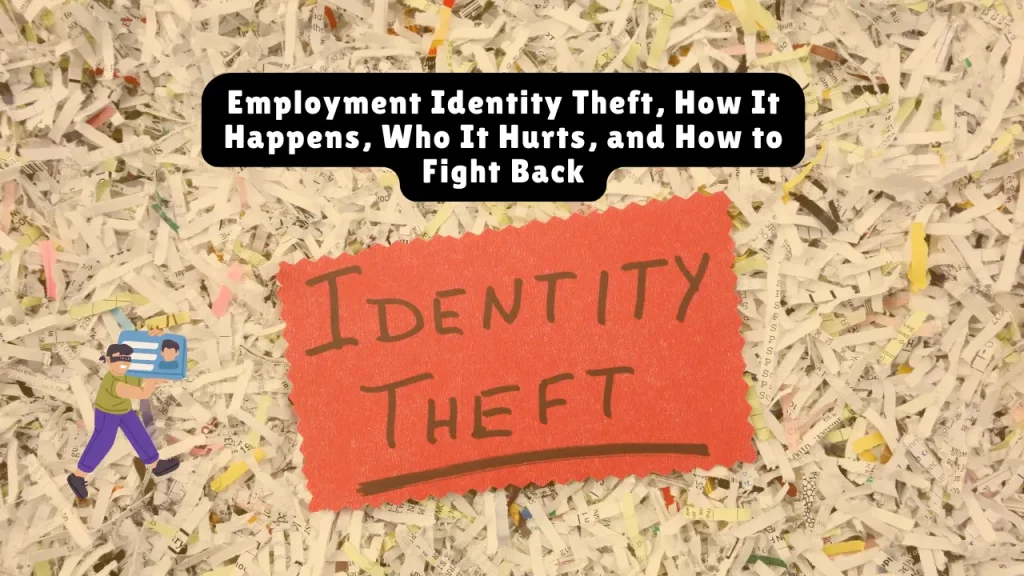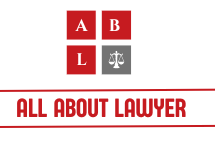Employment Identity Theft, How It Happens, Who It Hurts, and How to Fight Back
Employment identity theft is a rapidly growing form of fraud where criminals use stolen personal information—particularly Social Security numbers—to gain employment, collect wages, or access workplace benefits. In 2020 alone, the U.S. Federal Trade Commission (FTC) logged over 316,500 reports of employment or tax-related identity theft, and the numbers have only increased with the digitalization of hiring processes.
This form of identity theft can wreak havoc on both victims and businesses—causing tax issues, financial loss, job denials, and reputational damage. Here’s everything you need to know: how it happens, how to detect it, and how both individuals and employers can protect themselves.
Table of Contents
What Is Employment Identity Theft?
Employment identity theft occurs when someone uses another person’s Social Security number (SSN), name, or credentials to fraudulently get a job or divert wages. Thieves may fabricate resumes, forge W-2s, or create false direct deposit accounts in your name, often only discovered when the real person receives unexpected IRS notices, unfamiliar W-2s, or sees incorrect Social Security Administration (SSA) earnings statements.
“Employment identity theft is unique in that victims often don’t realize it until tax season or when they’re denied government benefits. It’s an invisible crime until it hits hard,” says Eva Velasquez, President of the Identity Theft Resource Center.
How Employment Identity Theft Happens
1. Data Breaches and Insider Threats
Attackers often exploit poorly secured corporate systems to steal employee data. For instance, a 2025 breach at a payroll processing firm exposed over 36 million SSNs and addresses. Insiders with access to HR databases may also leak or sell this data.
2. Phishing & Social Engineering
Scammers impersonate HR reps or job recruiters via email, SMS, or LinkedIn to trick victims into revealing personal details. A 2024 campaign lured job seekers to a fake job portal to steal their SSNs and tax documents.
3. Physical Document Theft
Criminals often steal W-2 forms, tax filings, or pay stubs from unsecured mail or trash. One case involved a thief using a discarded W-2 to land jobs under a victim’s name—triggering a chain of IRS audits.
4. Synthetic Identity Fraud
Fraudsters create hybrid identities using real SSNs (often from children or the deceased) and fabricated names or addresses. A 2023 ring used synthetic IDs to collect over $1.2 million in wages across multiple states.
5. Fraudulent Job Applications
Criminals apply for jobs using stolen or synthetic identities, particularly in industries with weak background screening. A 2025 study found that 23% of gig economy platforms failed to verify applicants’ credentials.
6. Exploitation of Public Wi-Fi
Job seekers who use unsecured public networks to submit applications risk having their data intercepted by hackers. A 2024 survey found 31% of identity theft victims had used public Wi-Fi during job searches.
7. Resume Site Scraping & Credential Stuffing
Public job boards like Monster and CareerBuilder are often scraped for resumes containing personal data. Hackers also use botnets to test stolen credentials on HR portals, gaining access to payroll systems.
Employer-Side Weaknesses
Weak Background Checks
Manual I-9 verification or outsourcing checks to third parties may lead to breaches or delays. Paper-only onboarding processes are also vulnerable to forged documents, especially in high-volume hiring.
HR System Vulnerabilities
Many Applicant Tracking Systems (ATS) and HR platforms expose APIs that hackers can exploit to inject fake records or scrape data.
“Many employers aren’t aware that their ATS can be a direct attack vector. A misconfigured API can open the door to mass-scale identity fraud,” says Jake Moore, cybersecurity specialist at ESET.
Read also: Child Identity Theft in the US

Technical Attack Vectors
- Phishing & Data Leaks: Fake HR emails or breaches of job sites and payroll systems.
- Resume-Site Scraping: Bots harvest names, emails, and SSNs from public resumes.
- Credential Stuffing: Automated login attempts using stolen credentials from other data breaches.
Consequences for Victims
- IRS Trouble: Fraudulent wages under your SSN can lead to audits, delayed refunds, and tax disputes.
- Credit Damage: Thieves may open loans or credit cards, dropping your credit score by 100+ points.
- Professional Harm: Fake job histories can flag background checks and job screenings.
- Legal Risks: In extreme cases, victims may be wrongfully linked to criminal activities.
Consequences for Employers
- Fines & Legal Liability: Employers may face lawsuits or fines if they fail to detect fraudulent hires. In one case, companies paid $2.7 million for hiring over 400 workers under stolen identities.
- Reputation Damage: Media coverage of negligent hiring can tarnish a brand’s public image.
- Operational Risk: Fraudulent hires may mishandle sensitive tasks, causing financial or data loss.
How to Prevent Employment Identity Theft
For Individuals
- Limit SSN Sharing: Only provide SSNs during final hiring steps or for background checks.
- Shred Documents: Destroy tax forms, job offers, and pay stubs before disposal.
- Use a VPN: Protect data transmission on public Wi-Fi.
- Check Credit Reports Weekly: Visit AnnualCreditReport.com.
- Enable IRS IP PIN: Prevent unauthorized tax filings with a six-digit IRS PIN.
- Monitor for W-2 or SSA Anomalies: Watch for unfamiliar income reports.
Identity Protection Services
Tools like Aura, LifeLock, and Identity Guard monitor for dark web leaks, SSN misuse, and suspicious credit activity. Some offer up to $1 million in insurance for legal or financial recovery.
For Employers
- E-Verify Integration: Automatically validate SSNs with DHS and SSA records.
- Digital-Only I-9s: Move from paper forms to encrypted digital records.
- Encrypt HR Data: Apply firewalls, MFA, and endpoint protection.
- Use Verified Vendors: Choose background-check vendors compliant with FCRA.
- Anomaly Detection: Implement machine learning models to flag:
- Duplicate SSNs
- Unusual direct deposit accounts
- Abnormal payroll entries
- Duplicate SSNs
“AI-based anomaly detection in payroll systems is a game-changer for flagging ghost employees and spotting fraud early,” says Dr. Hany Farid, digital forensics expert at UC Berkeley.
Regulatory & Legal Frameworks
- Federal Protections:
- Fair Credit Reporting Act (FCRA) ensures accuracy in employment screening.
- E-Verify checks SSNs against federal databases.
- Fair Credit Reporting Act (FCRA) ensures accuracy in employment screening.
- State Laws:
- California Senate Bill 328 mandates rapid reporting of I-9 irregularities.
- State data-breach laws (e.g., Massachusetts, New York) require prompt employee notification.
- California Senate Bill 328 mandates rapid reporting of I-9 irregularities.
What to Do If You’re a Victim
- Report to FTC: File a case at IdentityTheft.gov.
- Contact IRS: Submit Form 14039 (Identity Theft Affidavit).
- Notify SSA: Request an Earnings Suspense File review.
- Freeze Credit: Place alerts with Equifax, TransUnion, and Experian.
- Inform Employers: Share a police report and correct employment records.
Case Studies & Notable Prosecutions
- 400-ID California Scam (2025): A woman was charged with using over 400 stolen identities to get jobs and healthcare. Victims faced audits, credit loss, and loan rejections.
- North Korean IT Ring: DOJ exposed a ring where North Korean agents used stolen U.S. IDs to gain remote employment, funnelling income back to sanctioned entities.
- ITIN Misuse Audit (2024): The IRS tightened regulations after discovering widespread fraudulent use of Individual Taxpayer Identification Numbers.
Future Threats to Watch
- AI-Generated Resume Fraud: Tools like ChatGPT are being weaponized to create fake resumes indistinguishable from real ones.
- Blockchain-Based IDs: Decentralized identity systems may prevent fraud—but adoption is still years away.
Tools, Resources & Training
- Vendor Platforms: Onfido, Checkr, and HireRight for ID verification and continuous screening.
- Open-Source Anomaly Detection: Tools like scikit-learn can model fraud detection.
- HR Training: Annual phishing and document fraud workshops for HR staff.
Final Thoughts
Employment identity theft exploits both human error and system weaknesses. It’s not just a personal problem—it’s an institutional crisis. Whether you’re a job seeker or an HR director, your vigilance is essential.
Key Takeaway:
“Your Social Security number is as valuable as your bank account. Treat it like digital gold—guard it fiercely, monitor it regularly, and act fast when something seems off,” — Teresa Murray, Consumer Watchdog, U.S. PIRG.
Quick Links
- FTC Identity Theft Recovery: IdentityTheft.gov
- IRS Tax Fraud Info: IRS Identity Protection
- Free Weekly Credit Reports: AnnualCreditReport.com
About the Author

Sarah Klein, JD, is a former consumer rights attorney who spent years helping clients with issues like unfair billing, product disputes, and debt collection practices. At All About Lawyer, she simplifies consumer protection laws so readers can defend their rights and resolve problems with confidence.
Read more about Sarah
